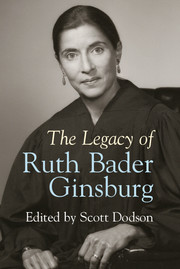Book contents
- Frontmatter
- Contents
- Contributors
- Preface
- Acknowledgments
- Part I Shaping a Legacy
- Part II Rights and Remedies
- 6 “Seg Academies,” Taxes, and Judge Ginsburg
- 7 A More Perfect Union
- 8 Barriers to Entry and Justice Ginsburg’s Criminal Procedure Jurisprudence
- 9 A Liberal Justice’s Limits
- Part III Structuralism
- Part IV The Jurist
- Notes
- Index
9 - A Liberal Justice’s Limits
Justice Ruth Bader Ginsburg and the American Criminal Justice System
Published online by Cambridge University Press: 05 February 2015
- Frontmatter
- Contents
- Contributors
- Preface
- Acknowledgments
- Part I Shaping a Legacy
- Part II Rights and Remedies
- 6 “Seg Academies,” Taxes, and Judge Ginsburg
- 7 A More Perfect Union
- 8 Barriers to Entry and Justice Ginsburg’s Criminal Procedure Jurisprudence
- 9 A Liberal Justice’s Limits
- Part III Structuralism
- Part IV The Jurist
- Notes
- Index
Summary
Introduction
No observer of Justice Ruth Bader Ginsburg’s career in the law can miss the tension between her unflinching support for substantive justice and her tempered view of the “measured” judicial steps possible under that flag. That contrast is starkly posed by a snapshot comparison between her praxis as a lawyer and her praxis as a judge. Though the 1970s and 1980s, Ginsburg exercised a guiding hand in roughly sixty cases concerning gender equality, including a dozen at the high court, in her capacity as co-founder of the American Civil Liberties Union’s Women’s Rights Project. These cases crystallized a novel principle that the state cannot regulate based on stereotypes “about the way women are” so as to “create or perpetuate the legal, social, and economic inferiority of women.” This supple, historically sensitive understanding of anti-discrimination, once installed, marked a dramatic departure from American law’s anterior treatment of women. It also stood as a remarkable foil to the failure of the then-pending Equal Rights Amendment to the Constitution – a contentious political process that might well have caused the Court to stay its hand had it been dealing with less skilled advocates.
By contrast, Ginsburg has insisted upon a more chastened role for federal judges in controversial domains of social policy during her time on the federal bench. Rather than boldly venturing where popular majorities fear to tread, she has warned, federal courts should rarely and hesitantly “step ahead” of democratic sentiment as articulated by the national political branches. Instead, she explained, judges should write “modestly” by opening “a dialogue” with the political branches. Courts, she has explained in a later majority opinion, “do not, or should not, sally forth each day looking for wrongs to right.” As befits a legatee of the Legal Process School associated with Henry Hart and Albert Sacks of the Harvard Law School, Ginsburg glosses her judicial restraint by focusing on the reticulated institutional dynamics of our federal system. Invoking concerns with both institutional competence and political-feedback effects, she has highlighted the impediments any single federal judge must navigate to secure conformity with constitutional principles. That judge, she cautioned, must persuade not only a majority of her multimember Court but also the coordinate branches of government, as well as a national public ready to rally against over-reaching judgments and “turn the legislative tide in the opposition direction.”
- Type
- Chapter
- Information
- The Legacy of Ruth Bader Ginsburg , pp. 117 - 134Publisher: Cambridge University PressPrint publication year: 2015

